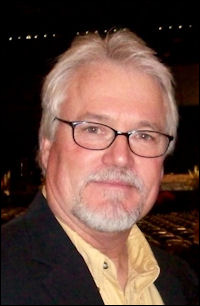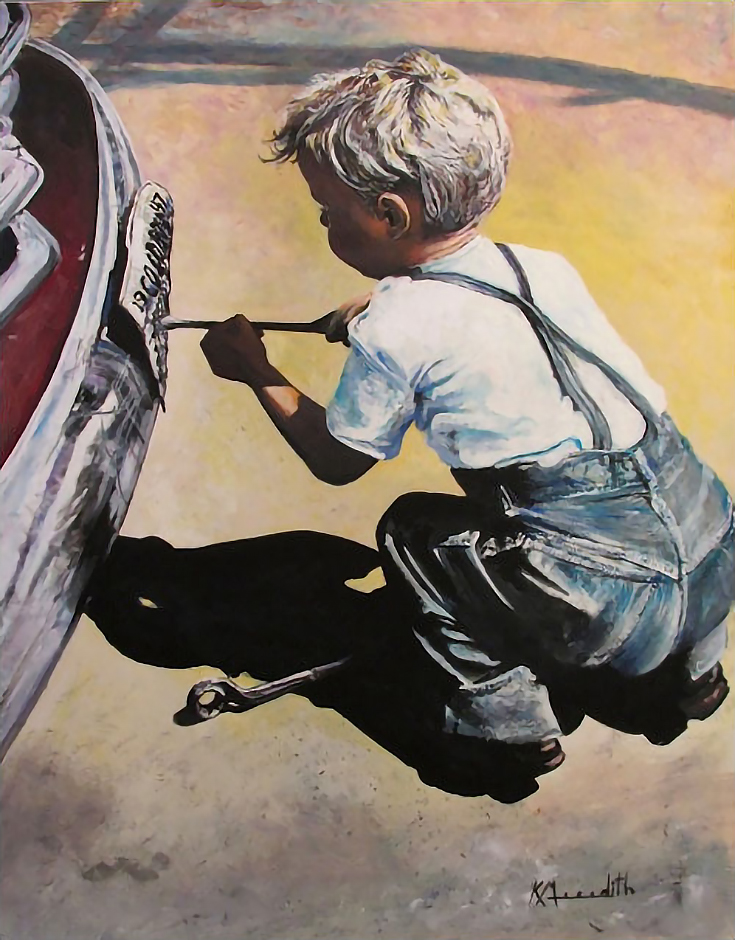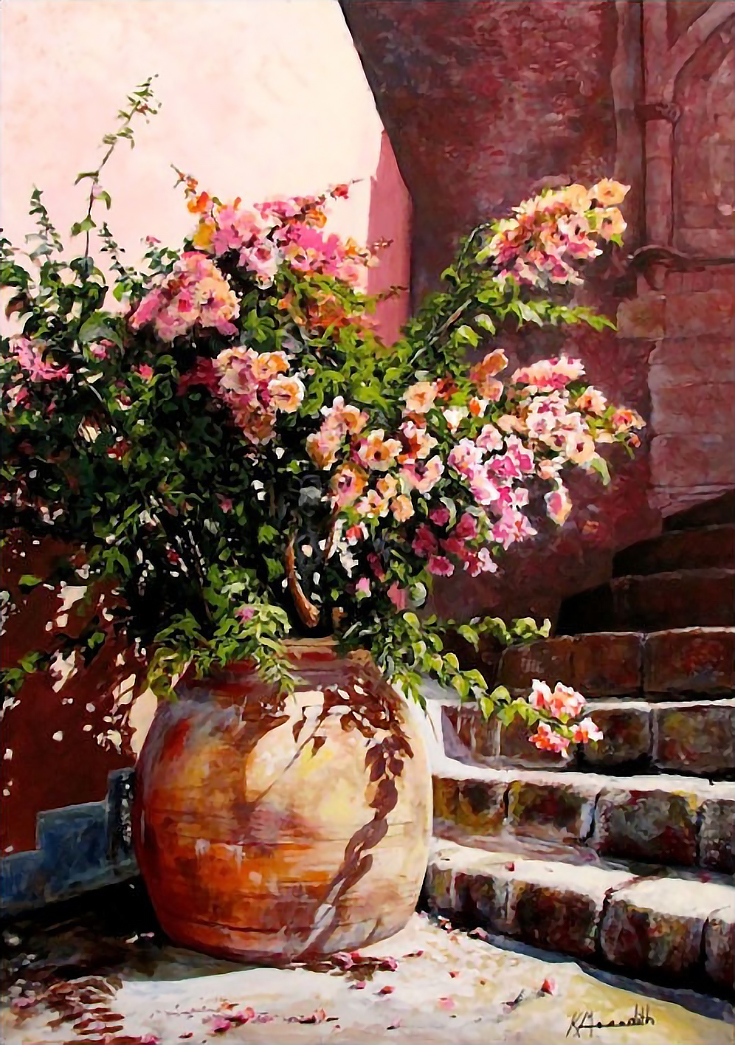
Then one day he approached his fine custom furniture clients with an idea. . . he’d bring in foot traffic by hosting a one-man art show in their facilities. Since 2001, he has hosted 25 furniture gallery art shows where he successfully sold both original paintings and high-quality reproductions. Today, he continues to market his work through online sites like etsy.
Alyice: Why did you choose acrylic as your medium?
Kevin: I’ve been painting with acrylics for the past couple years. Prior to using acrylic paints, oil paints were my choice medium. I find that cost savings alone is not reason enough to make the change. However, acrylics do offer a unique blending of styles.
With a simple thinning you can capture a water color look and applying a thick amount of acrylic can give you a textured surface—like you see in oil paintings.
What I enjoy the most about water base paints is that it dries very quickly—with a bit of opaqueness. This requires you to add new layers to bring out the true color hue which forces you to learn to blend.
With oils it can be one stroke and you are done but with acrylics it may mean three or four strokes to reach color tone desired.
Alyice: What is the most challenging part about working with acrylics?
Kevin: Drying time is a wonderful advantage, but it also presents the biggest challenge… the blending of large areas to be more specific.
You must maintain a wet surface in order to blend colors. If the area is just too large to maintain the moister you have to coat the area in a color wash (multiple times). It might be the only means by which to accomplish the task.
For most of my shows, I get to demonstrate my painting style as well as interact with potential customers. Oddly enough, I really enjoy do this. With acrylics it is easy to push through a painting very quickly. . . enabling a customer to witness my ability and hopefully it helps in the marketing of my work.
Alyice: What is the best part about working with acrylics?
Kevin: Again it’s drying time.
I like being able to brush a layer of paint on the canvas and in a few minutes its dry enough to add another color on top. Another part I like is being able to add layers in order to achieve the true color hue—which in turn lends in the effort to create depth. And, clean-up is easy. . . there’s no oil smell that permeates everything.
Alyice: Do you do anything in particular to seal your art?
Kevin: All of my originals get two coats of a matte lacquer finish to protect them from moisture and other environmental issues.
A lacquer finish allows clients to safely clean the painting with a damp cloth and archives the painting at the same time. Product brand is not that important to me as long as it’s designed for acrylic paints.
Alyice: What is your creative process like?
Kevin: The process begins with a photo that has a meaning; a photo that tells a story or evokes an emotion.
Usually, I will crop the picture to enhance the subject matter. Then I process the picture through Photoshop to see if color change gives it more meaning. After this, I decide what size the painting will be. If it’s a small painting, say 16 x 20 or less, I tend not to sketch what I’m about to paint. I’d rather just let the paint brush be the pencil. For larger paintings, however, I will rough sketch before any paint is applied.
As an artist the most challenging and enjoyable work for me is in portraits. I’m amazed with artists who can paint photographically. Most of the old master painters could paint this way and for the most part, chose to be known as impressionist artist.
Alyice: How has your style changed over the years?
Kevin: I can’t say that my style has changed, but my use of colors evolves constantly and making my work marketable meant choosing to paint what the public wants to purchase.
Alyice: What do you believe is a key element in creating a good composition?
Kevin: A good color palette.
You hear from time to time—from other artist as well as art critiques—that an art piece has a good color palette. Which can mean things like the colors are well coordinated in contrast with other colors. A very nice compliment to hear.
Another key is maintaining confidence in yourself as an artist. It may mean that you just step back and take a simple look at what you’ve done. One means of maintaining a good composition, for me, is to go on gallery field trips for inspiration or just view other artist work on the internet.
Alyice: How do you come up with a profitable pricing structure for your acrylic pieces?
Kevin: For the most part unless you have a name in the art world you pretty much have to look at other artists work that is similar to yours and price accordingly. Other factors come into play such as geographic location and demand for what you produce.
The pricing at my shows tend to be a little higher because you get to be a sales person or the promoter. Commission work can garnish a 30% to 40% up-charge because I am painting something I would not normally paint and because they tend to be a little more difficult to complete.
You can learn more about Kevin and his art by visiting kevinmeredith.etsy.com.
This post may contain affiliate links.



